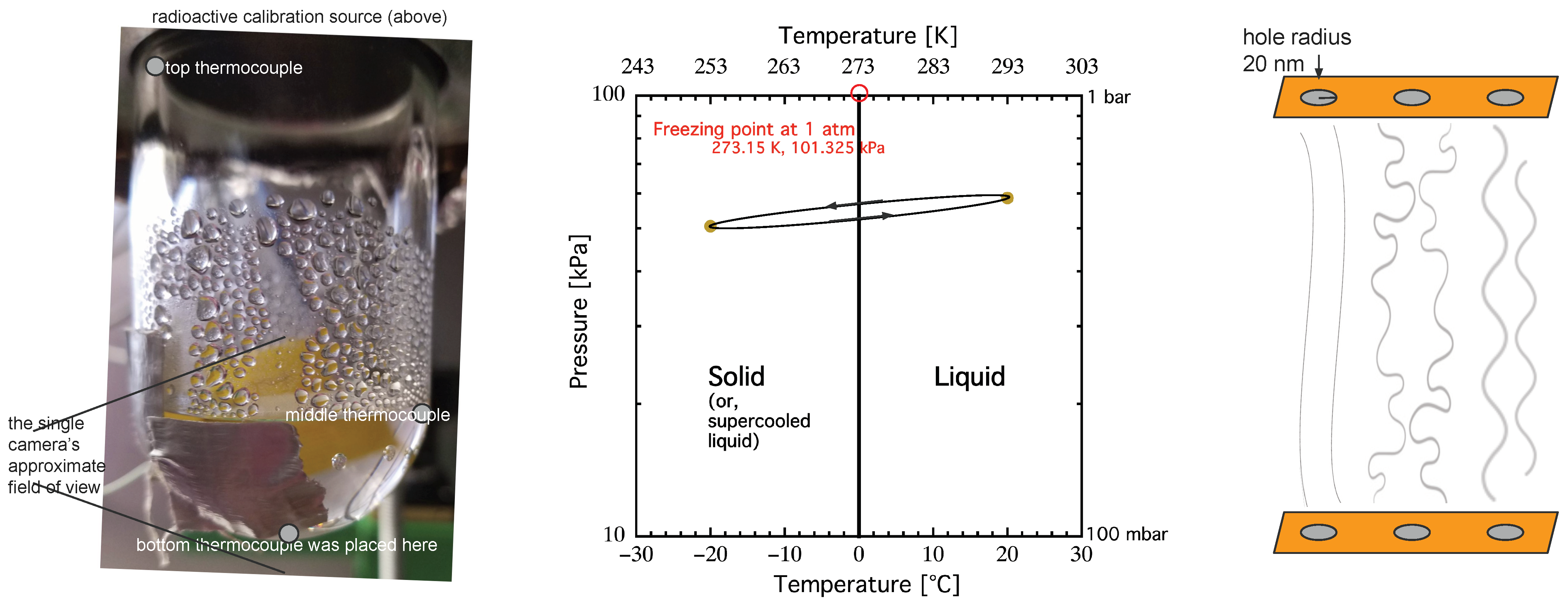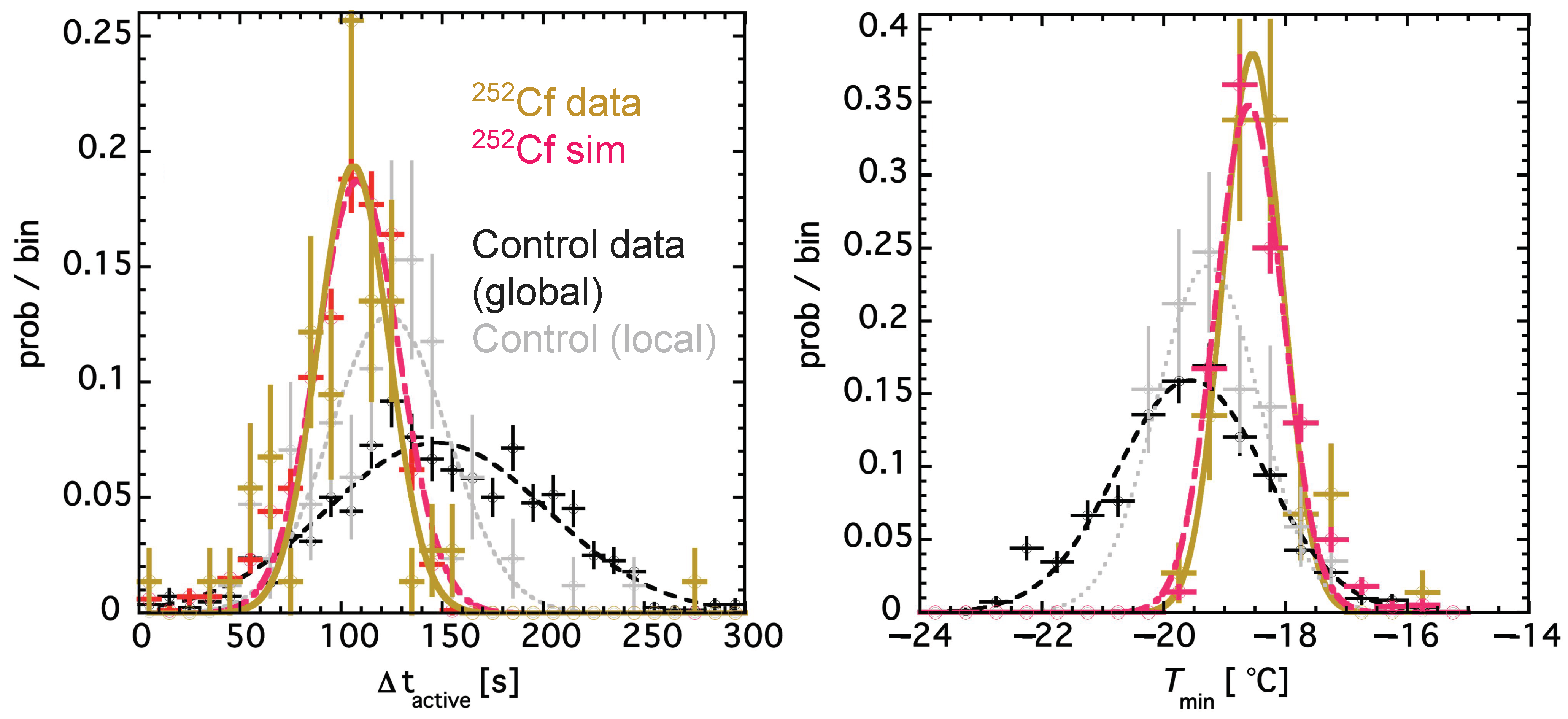A Simple Model of the Energy Threshold for Snowball Chambers
Abstract
1. Introduction
2. Materials and Methods

3. Results
3.1. G4 Monte Carlo
3.2. Custom Simulation of Thresholds
3.3. Possible Energy Reconstruction
4. Discussion
5. Conclusions
Author Contributions
Funding
Data Availability Statement
Acknowledgments
Conflicts of Interest
References
- Cooley, J.; Lin, T.; Lippincott, W.H.; Slatyer, T.R.; Yu, T.-T.; Akerib, D.S.; Aramaki, T.; Baxter, D.; Bringmann, T.; Bunker, R.; et al. Report of the Topical Group on Particle Dark Matter for Snowmass 2021. arXiv 2022, arXiv:2209.07426. [Google Scholar]
- Akimov, D.; Albert, J.B.; An, P.; Awe, C.; Barbeau, P.S.; Becker, B.; Belov, V.; Brown, A.; Bolozdynya, A.; Cabrera-Palmer, B.; et al. Observation of coherent elastic neutrino-nucleus scattering. Science 2017, 357, 1123–1126. [Google Scholar] [CrossRef]
- Fukuda, S.; Fukuda, Y.; Hayakawa, T.; Ichihara, E.; Ishitsuka, M.; Itow, Y.; Kajita, T.; Kameda, J.; Kaneyuki, K.; Kasuga, S.; et al. The Super-Kamiokande detector. Nucl. Instrum. Methods Phys. Res. Sect. A Accel. Spectrometers Detect. Assoc. Equip. 2003, 501, 418–462. [Google Scholar] [CrossRef]
- Behnke, E.; Behnke, J.; Brice, S.J.; Broemmelsiek, D.; Collar, J.I.; Conner, A.; Cooper, P.S.; Crisler, M.; Dahl, C.E.; Fustin, D.; et al. First dark matter search results from a 4-kg CF3I bubble chamber operated in a deep underground site. Phys. Rev. D 2012, 86, 052001. [Google Scholar] [CrossRef]
- Amole, C.; Ardid, M.; Arnquist, I.J.; Asner, D.M.; Baxter, D.; Behnke, E.; Bressler, M.; Broerman, B.; Cao, G.; Chen, C.J.; et al. Dark matter search results from the complete exposure of the PICO-60 C3F8 bubble chamber. Phys. Rev. D 2019, 100, 022001. [Google Scholar] [CrossRef]
- Dorsey, N.E. The Freezing of Supercooled Water. Trans. Am. Philos. Soc. 1948, 38, 247–328. [Google Scholar] [CrossRef]
- Mossop, S.C. The Freezing of Supercooled Water. Proc. Phys. Soc. Sect. B 1955, 68, 193. [Google Scholar] [CrossRef]
- Holten, V.; Sengers, J.V.; Anisimov, M.A. Equation of State for Supercooled Water at Pressures up to 400 MPa. J. Phys. Chem. Ref. Data 2014, 43, 043101. [Google Scholar] [CrossRef]
- Agarwal, V.; Gilra, N. Crystal density in supercooled radiation detector. Nucl. Instrum. Methods 1966, 40, 238–240. [Google Scholar] [CrossRef]
- Pisarev, A.F. On Ion Detection in Supercooled Liquids; Report number: CERN-TRANS-67-7; CERN: Meyrin, Switzerland, November 1967; 13p. [Google Scholar]
- Varshneya, N.C. Detecting Radiation with a Supercooled Liquid. Nature 1969, 223, 826–827. [Google Scholar] [CrossRef]
- Deitrich, L.W.; Connolly, T.J. A Study of Fission-Fragment-Induced Nucleation of Bubbles in Superheated Water. Nucl. Sci. Eng. 1973, 50, 273–282. [Google Scholar] [CrossRef]
- Barahona, D. Thermodynamic derivation of the activation energy for ice nucleation. Atmos. Chem. Phys. 2015, 15, 13819–13831. [Google Scholar] [CrossRef]
- Barahona, D. On the thermodynamic and kinetic aspects of immersion ice nucleation. Atmos. Chem. Phys. 2018, 18, 17119–17141. [Google Scholar] [CrossRef]
- Marcolli, C. Technical note: Fundamental aspects of ice nucleation via pore condensation and freezing including Laplace pressure and growth into macroscopic ice. Atmos. Chem. Phys. 2020, 20, 3209–3230. [Google Scholar] [CrossRef]
- Khvorostyanov, V.; Curry, J. The Theory of Ice Nucleation by Heterogeneous Freezing of Deliquescent Mixed CCN. Part I: Critical Radius, Energy, and Nucleation Rate. J. Atmos. Sci. 2004, 61, 2676–2691. [Google Scholar] [CrossRef]
- Limmer, D.T.; Chandler, D. Phase diagram of supercooled water confined to hydrophilic nanopores. J. Chem. Phys. 2012, 137, 044509. [Google Scholar] [CrossRef]
- Nevzorov, A. Some properties of metastable states of water. Phys. Wave Phenom. 2006, 1460, 92. [Google Scholar]
- Bigg, E. The Supercooling of Water. Proc. Phys. Soc. Sect. B 1953, 66, 688. [Google Scholar] [CrossRef]
- Szydagis, M.; Levy, C.; Huang, Y.; Kamaha, A.C.; Knight, C.C.; Rischbieter, G.R.C.; Wilson, P.W. Demonstration of Neutron Radiation-Induced Nucleation of Supercooled Water. Phys. Chem. Chem. Phys. 2021, 23, 13440–13446. [Google Scholar] [CrossRef] [PubMed]
- Agostinelli, S.; Allison, J.; Amako, K.; Apostolakis, J.; Araujo, H.; Arce, P.; Asai, M.; Axen, D.; Banerjee, S.; Barrand, G.; et al. Geant4: A Simulation Toolkit. Nucl. Instrum. Methods Phys. Res. Sect. A Accel. Spectrometers Detect. Assoc. Equip. 2003, 506, 250–303. [Google Scholar] [CrossRef]
- Allison, J.; Amako, K.; Apostolakis, J.; Araujo, H.; Dubois, P.A.; Asai, M.; Barrand, G.; Capra, R.; Chauvie, S.; Chytracek, R.; et al. Geant4 Developments and Applications. IEEE Trans. Nucl. Sci. 2006, 53, 270–278. [Google Scholar] [CrossRef]
- Dahl, C.E. The Physics of Background Discrimination in Liquid Xenon, and First Results from XENON10 in the Hunt for WIMP Dark Matter. Ph.D. Thesis, Princeton University, Princeton, NJ, USA, 2009. [Google Scholar]
- Aprile, E.; Angle, J.; Arneodo, F.; Baudis, L.; Bernstein, A.; Bolozdynya, A.; Brusov, P.; Coelho, L.; Dahl, C.; DeViveiros, L.; et al. Design and performance of the XENON10 dark matter experiment. Astropart. Phys. 2011, 34, 679–698. [Google Scholar] [CrossRef]
- Varshneya, N. Theory of radiation detection through supercooled liquid. Nucl. Instrum. Methods 1971, 92, 147–150. [Google Scholar] [CrossRef]
- McCabe, C. Astrophysical uncertainties of dark matter direct detection experiments. Phys. Rev. D 2010, 82, 023530. [Google Scholar] [CrossRef]
- Atkinson, J.D.; Murray, B.J.; O’Sullivan, D. Rate of Homogenous Nucleation of Ice in Supercooled Water. J. Phys. Chem. A 2016, 120, 6513–6520. [Google Scholar] [CrossRef] [PubMed]
- Szydagis, M. Dark Matter Limits from a 15 kg Windowless Bubble Chamber. Ph.D. Thesis, The University of Chicago, Chicago, IL, USA, 2011. [Google Scholar] [CrossRef]
- Seitz, F. On the Theory of the Bubble Chamber. Phys. Fluids 1958, 1, 2–13. [Google Scholar] [CrossRef]
- Behnke, E.; Besnier, M.; Bhattacharjee, P.; Dai, X.; Das, M.; Davour, A.; Debris, F.; Dhungana, N.; Farine, J.; Fines-Neuschild, M.; et al. Final results of the PICASSO dark matter search experiment. Astropart. Phys. 2017, 90, 85–92. [Google Scholar] [CrossRef]
- NIST. ESTAR. 2019. Available online: https://physics.nist.gov/PhysRefData/Star/Text/ESTAR.html (accessed on 15 July 2020).
- NIST. PSTAR. 2019. Available online: https://physics.nist.gov/PhysRefData/Star/Text/PSTAR.html (accessed on 15 July 2020).
- Ziegler, J.F.; Ziegler, M.D.; Biersack, J.P. SRIM—The stopping and range of ions in matter. Nucl. Instrum. Methods Phys. Res. B 2010, 268, 1818–1823. [Google Scholar] [CrossRef]
- Behnke, E.; Benjamin, T.; Brice, S.J.; Broemmelsiek, D.; Collar, J.I.; Cooper, P.S.; Crisler, M.; Dahl, C.E.; Fustin, D.; Hall, J.; et al. Direct measurement of the bubble nucleation energy threshold in a CF3I bubble chamber. Phys. Rev. D 2013, 88, 021101. [Google Scholar] [CrossRef]
- Aprile, E.; Aalbers, J.; Agostini, F.; Alfonsi, M.; Althueser, L.; Amaro, F.D.; Antochi, V.C.; Angelino, E.; Arneodo, F.; Barge, D.; et al. Light Dark Matter Search with Ionization Signals in XENON1T. Phys. Rev. Lett. 2019, 123, 251801. [Google Scholar] [CrossRef]
- Baxter, D.; Chen, C.J.; Crisler, M.; Cwiok, T.; Dahl, C.E.; Grimsted, A.; Gupta, J.; Jin, M.; Puig, R.; Temples, D.; et al. First Demonstration of a Scintillating Xenon Bubble Chamber for Detecting Dark Matter and Coherent Elastic Neutrino-Nucleus Scattering. Phys. Rev. Lett. 2017, 118, 231301. [Google Scholar] [CrossRef]
- Alonso, J.R.; Barros, N.; Bergevin, M.; Bernstein, A.; Bignell, L.; Blucher, E.; Calaprice, F.; Conrad, J.M.; Descamps, F.B.; Diwan, M.V.; et al. Advanced Scintillator Detector Concept (ASDC): A Concept Paper on the Physics Potential of Water-Based Liquid Scintillator. arXiv 2014, arXiv:1409.5864. [Google Scholar]
- Huang, H.; Yarmush, M.; Usta, B. Long-term deep supercooling of large-volume water via surface sealing with immiscible liquids. Nat. Commun. 2018, 9, 3201. [Google Scholar] [CrossRef] [PubMed]
- de Vries, R.J.; Tessier, S.N.; Banik, P.D.; Nagpal, S.; Cronin, S.E.J.; Ozer, S.; Hafiz, E.O.A.; van Gulik, T.M.; Yarmush, M.L.; Markmann, J.F.; et al. Supercooling extends preservation time of human livers. Nat. Biotechnol. 2019, 37, 1131–1136. [Google Scholar] [CrossRef] [PubMed]
- Schiller, R.; Kules, I. Radiation chemistry of supercooled water. J. Phys. Chem. 1971, 75, 2997–2999. [Google Scholar] [CrossRef]
- Hare, D.E.; Sorensen, C.M. Raman spectroscopic study of bulk water supercooled to −33 °C. J. Chem. Phys. 1990, 93, 25–33. [Google Scholar] [CrossRef]
- Belitzky, A.; Mishuk, E.; Ehre, D.; Lahav, M.; Lubomirsky, I. The Source of Electro-Freezing of Super-Cooled Water by Polar Crystals. J. Phys. Chem. Lett. 2016, 7, 43–46. [Google Scholar] [CrossRef]
- Goy, C.; Potenza, M.A.C.; Dedera, S.; Tomut, M.; Guillerm, E.; Kalinin, A.; Voss, K.O.; Schottelius, A.; Petridis, N.; Prosvetov, A.; et al. Shrinking of Rapidly Evaporating Water Microdroplets Reveals their Extreme Supercooling. Phys. Rev. Lett. 2018, 120, 015501. [Google Scholar] [CrossRef]
- Hare, D.E.; Sorensen, C.M. The density of supercooled water. II. Bulk samples cooled to the homogeneous nucleation limit. J. Chem. Phys. 1987, 87, 4840–4845. [Google Scholar] [CrossRef]
- Bat, A.; Tiras, E.; Fischer, V.; Kamislioglu, M. Low energy neutrino detection with a compact water-based liquid scintillator detector. Eur. Phys. J. C 2022, 82, 734. [Google Scholar] [CrossRef]
- Alfonso-Pita, E.; Flores, L.J.; Peinado, E.; Vázquez-Jáuregui, E. New physics searches in a low threshold scintillating argon bubble chamber measuring coherent elastic neutrino-nucleus scattering in reactors. Phys. Rev. D 2022, 105, 113005. [Google Scholar] [CrossRef]
- Aubin, F.; Auger, M.; Genest, M.H.; Giroux, G.; Gornea, R.; Faust, R.; Leroy, C.; Lessard, L.; Martin, J.P.; Morlat, T.; et al. Discrimination of nuclear recoils from alpha particles with superheated liquids. New J. Phys. 2008, 10, 103017. [Google Scholar] [CrossRef]
- Essig, R.; Giovanetti, G.K.; Kurinsky, N.; McKinsey, D.N.; Ramanathan, K.; Stifter, K.; Yu, T.-T.; Aboubrahim, A.; Adams, D.; Alves, D.S.M.; et al. Snowmass2021 Cosmic Frontier: The landscape of low-threshold dark matter direct detection in the next decade. arXiv 2022, arXiv:2203.08297. [Google Scholar]





| Calib Source | Activity [Ci] | Total Rate | NR [Hz] n+(,n) | ER Rate [Hz] |
|---|---|---|---|---|
| 252Cf fission | 1.0 (all radiation) | ≈3000 n/s | 14.2 (2.7) | 13.4 (<8 × 10−4) |
| 137Cs gammas | 10 (100% rays) | 3.7 × /s | <4 × 10−2 | 570 (<4 × 10−2) |
Disclaimer/Publisher’s Note: The statements, opinions and data contained in all publications are solely those of the individual author(s) and contributor(s) and not of MDPI and/or the editor(s). MDPI and/or the editor(s) disclaim responsibility for any injury to people or property resulting from any ideas, methods, instructions or products referred to in the content. |
© 2024 by the authors. Licensee MDPI, Basel, Switzerland. This article is an open access article distributed under the terms and conditions of the Creative Commons Attribution (CC BY) license (https://creativecommons.org/licenses/by/4.0/).
Share and Cite
Szydagis, M.; Levy, C.; Bolotnikov, A.E.; Diwan, M.V.; Homenides, G.J.; Kamaha, A.C.; Martin, J.; Rosero, R.; Yeh, M. A Simple Model of the Energy Threshold for Snowball Chambers. Universe 2024, 10, 81. https://doi.org/10.3390/universe10020081
Szydagis M, Levy C, Bolotnikov AE, Diwan MV, Homenides GJ, Kamaha AC, Martin J, Rosero R, Yeh M. A Simple Model of the Energy Threshold for Snowball Chambers. Universe. 2024; 10(2):81. https://doi.org/10.3390/universe10020081
Chicago/Turabian StyleSzydagis, Matthew, Cecilia Levy, Aleksey E. Bolotnikov, Milind V. Diwan, George J. Homenides, Alvine C. Kamaha, Joshua Martin, Richard Rosero, and Minfang Yeh. 2024. "A Simple Model of the Energy Threshold for Snowball Chambers" Universe 10, no. 2: 81. https://doi.org/10.3390/universe10020081
APA StyleSzydagis, M., Levy, C., Bolotnikov, A. E., Diwan, M. V., Homenides, G. J., Kamaha, A. C., Martin, J., Rosero, R., & Yeh, M. (2024). A Simple Model of the Energy Threshold for Snowball Chambers. Universe, 10(2), 81. https://doi.org/10.3390/universe10020081





